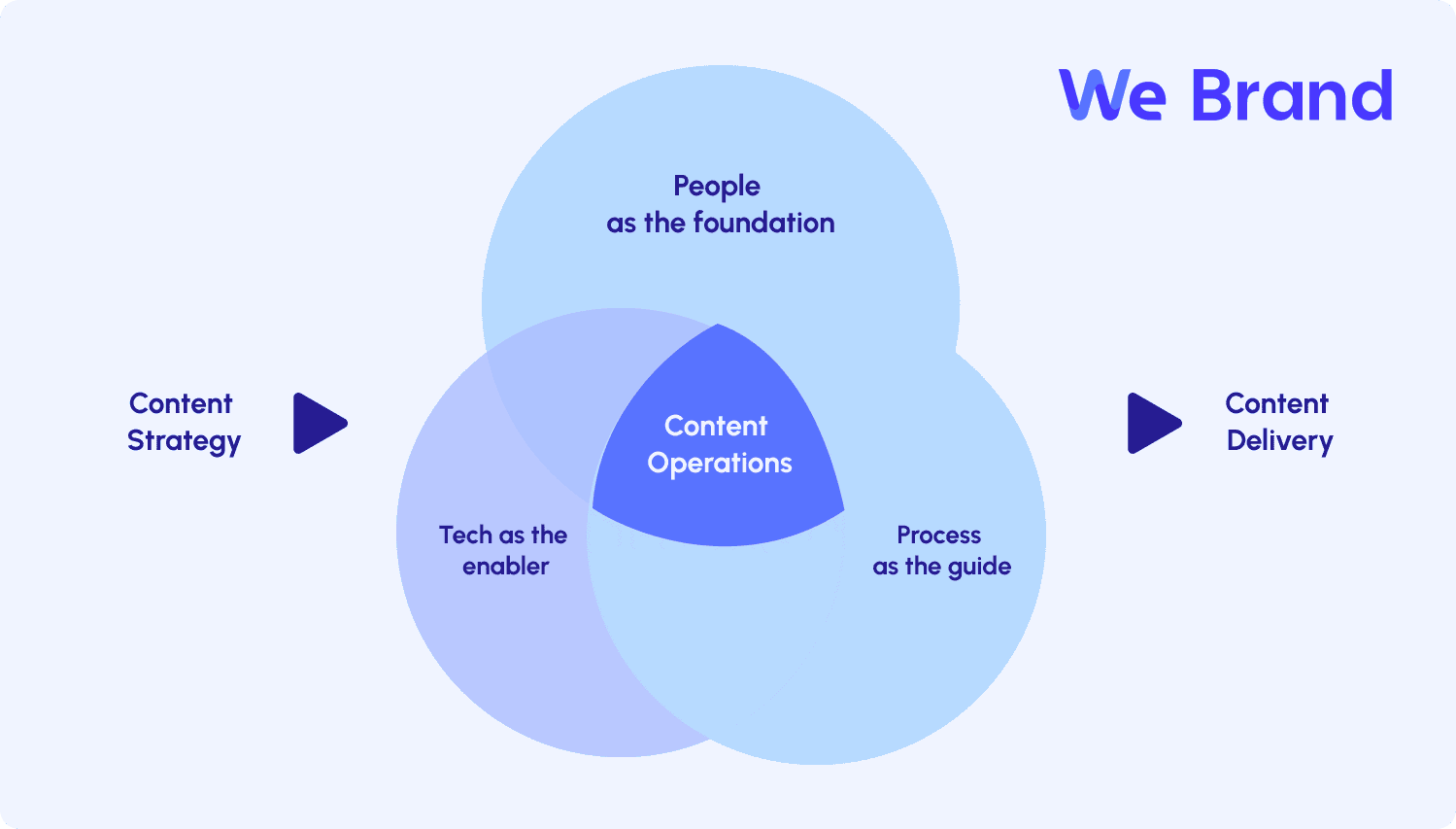Content chaos is real: too many assets, too many stakeholders, and zero visibility. Marketing teams waste hours chasing approvals instead of creating impact. Enter the Content Operations Manager—the role built to bring speed, structure, and sanity to complex enterprise marketing.
Why enterprise content operations need leadership
The pain points are familiar: siloed teams, duplicated assets, compliance bottlenecks, and brand guidelines that look great on paper but get ignored in practice. At scale, even tiny inefficiencies snowball fast.
It’s not just lost hours—it’s real risk. One rogue logo can erode years of brand equity. One outdated disclaimer can spark a compliance review or legal fire drill. The more markets and channels you manage, the higher the stakes.
I’ve been there, answering to a CMO, legal, and IT in the same week. The answer isn’t more process for process’s sake. It’s smarter orchestration.
Why the content operations manager is suddenly mission-critical
Five years ago, this role didn’t even exist in most org charts.
It emerged out of necessity, as marketing became more digital, regulated, and collaborative. Today, it’s as foundational as creative or analytics.
What’s driving the shift? Content is now the connective tissue of every customer experience—whether it’s a global launch, an ABM campaign, or real-time social engagement. Audiences expect consistency, accuracy, and relevance at every touchpoint.
The problem: complexity has exploded, but resources haven’t kept pace. Creative directors and brand managers are vital, but they’re not built to manage the operational machinery of content at scale. That’s a unique skillset—and it’s exactly where a content operations manager thrives.
The impact is real: After introducing a dedicated content ops lead, our time-to-market dropped by 40%, “where’s the latest version?” emails disappeared, and compliance issues fell. Not magic, orchestration. Someone finally owned the process, the tech, and the people side of content.
Key responsibilities of a content operations manager
The title can sound ambiguous. In practice, this is a hands‑on, cross‑functional leadership role that connects teams, removes friction, and makes sure every piece of content meets brand standards and serves the strategy.
1. Orchestrating content workflows and processes
- Map the path from brief to publish so every step is intentional and repeatable.
- Standardize intake, creative requirements, reviews, and sign‑offs with clear owners and SLAs.
- Outcome: fewer bottlenecks, shorter cycle times, on‑time launches.
Proof: During our rebrand, a living workflow across regions and agencies cut confusion and kept launch on schedule.
2. Manage the content tech stack to reduce duplication
- Integrate DAM, CMS, workflow, and analytics so tools match how teams work.
- Automate asset sync and metadata to end manual file moves and version chaos.
- Outcome: more self‑serve creation time, fewer errors, cleaner governance data.
Proof: Connecting our DAM to the CMS eliminated weekly hours of file handling and freed up creative capacity.
3. Embed brand governance and compliance in the process
- Turn guidelines into guardrails with checkpoints at the right moments.
- Use approval matrices so assets with claims or disclaimers route automatically.
- Outcome: consistency at scale without manual policing or last‑minute rewrites.
Proof: Partnering with legal to codify review paths caught issues early and protected launch timelines.
4. Scale localization and personalization without losing control
- Provide a playbook, versioned assets, and region metadata so local teams can adapt fast.
- Automate translation handoffs and approvals to cut handwork and misses.
- Outcome: faster time to market, fewer errors, relevance in every market.
Proof: For APAC, standardized versions and automated flows sped launches and reduced fixes.
5. Close the loop with measurement and optimization
- Track asset usage, performance, and operational efficiency to inform what gets made next.
- Use insights to adjust tagging, channel fit, and distribution patterns.
- Outcome: better alignment, higher engagement, continuous improvement.
Proof: Spotting underperformers tied to channel mismatch led to smarter distribution and stronger results.
Skills every content ops leader must master
So what makes a great content operations manager? The best ones I’ve worked with blend left-brain systems thinking with right-brain empathy. They’re part process architect, part technologist, part diplomat. Here’s what sets them apart in a fast-moving enterprise environment.
1. Systems thinking and process design
At its core, content ops is about building scalable systems. The best content operations managers can map out complex workflows, identify bottlenecks, and design processes that work for creative, compliance, and everyone in between. They see the whole chessboard and know how to orchestrate moves that keep content flowing without sacrificing quality.
One of our most effective content ops hires came from a project management background. She brought a knack for breaking down big challenges into manageable steps, building templates and checklists that teams actually wanted to use. Her superpower was making process feel empowering, not restrictive.
2. Technical fluency and tool integration
Content ops is increasingly tech-driven. From DAM integrations to workflow automation, a great content operations manager is comfortable speaking both marketing and IT. They understand APIs, data privacy, and the nuances of enterprise-grade platforms. But just as importantly, they have the people skills to translate technical possibilities into practical benefits for the business.
Our recent migration to a new CMS was smoother because our content ops manager partnered closely with IT and security, flagging integration risks early and advocating for user experience. It wasn’t just about deploying new tech, it was about making sure it actually solved our real-world pain points.
The next-gen DAM for enterprise
Get more than just storage. Get the DAM that dramatically improves content velocity and brand compliance.3. Brand and compliance acumen
You can’t manage content at scale without a deep understanding of brand standards, regulatory risk, and the nuances of your industry. The best content ops managers are as comfortable debating the finer points of brand voice as they are reviewing legal disclaimers. They know when to push for creative flexibility and when to hold the line.
In financial services, for example, our content ops lead worked hand-in-hand with compliance to develop an approval matrix for every asset. They anticipated regulatory changes, updated workflows proactively, and became a trusted bridge between marketing and legal. That kind of foresight is worth its weight in gold.
4. Communication and stakeholder management
Enterprise content is a team sport. A content operations manager is constantly aligning creative, brand, legal, IT, and regional marketing teams. That means communicating clearly, managing expectations, and resolving conflicts before they derail momentum.
One of the most valuable skills I’ve seen is the ability to facilitate working sessions that bring stakeholders together around a shared goal. Our content ops manager turned what could have been a contentious asset review process into a collaborative sprint, with clear roles and timelines. The result: Fewer surprises, more buy-in, and assets that sailed through approvals.
How content ops connects departments
This isn’t a siloed role. The content operations manager is the connective tissue between marketing, IT, legal, compliance, creative, and even external partners. Here’s how those relationships typically play out in practice, based on what I’ve seen in large organizations.
Here’s where they make an impact:
- With creative: Translating strategy into usable systems
- With legal: Automating risk management into workflows
- With IT: Making tech work for how teams operate
- With partners: Keeping every agency aligned and on brand
1. With marketing leadership and creative teams
The content operations manager is a strategic partner to CMOs, VPs, and creative directors. They translate big-picture brand strategy into operational reality. That means helping creative teams focus on ideation and execution, not chasing down approvals or version control issues.
When we rolled out our new global brand guidelines, our content ops manager ran workshops with each regional team, translating high-level principles into practical workflows and templates. The feedback was clear: Creative teams felt empowered, not policed. That’s the sweet spot.
2. With IT, CIOs, and CTOs
Content ops is inseparable from technology. The content operations manager works hand-in-hand with IT to evaluate new tools, ensure integrations are secure, and maintain data privacy standards. They’re the voice of the user in technical conversations, advocating for solutions that actually move the needle.
During our DAM upgrade, our content ops manager flagged a potential API limitation that would have broken our localization workflow. By surfacing the issue early, they saved us weeks of rework and kept the project on track. IT appreciated having a partner who understood both the business and technical stakes.
3. With legal, compliance, and risk teams
No one wants to be the reason a campaign gets delayed for legal review. The content operations manager builds bridges to compliance and risk, designing workflows that bake in necessary checks without grinding marketing to a halt.
For our regulated healthcare campaigns, our content ops lead set up automated routing for any asset containing medical claims. Legal got the context they needed, creative avoided endless back-and-forth, and leadership got peace of mind that nothing would slip through the cracks.
4. With external partners and agencies
Enterprise marketing rarely happens in a vacuum. The content operations manager is the point person for external agencies, localization vendors, and technology partners. They ensure everyone is working from the same playbook, using the right templates, and following the same processes.
In our last product launch, our content ops manager ran weekly standups with agency partners, sharing real-time updates on asset status and approvals. The result was fewer missed deadlines, less duplication, and a much smoother path to launch.
Business impact of content ops managers
The proof, as they say, is in the results. When we put real focus and talent behind content operations, the impact ripples out across every facet of enterprise marketing. These aren’t just hypothetical benefits; they’re outcomes I’ve seen firsthand.
Content ops isn’t a nice-to-have, it’s the reason our campaigns launch 40% faster, our teams stop duplicating work, and compliance finally becomes part of the flow.
We Brand Marketing team🚀 What changes with content ops:
- 40% faster campaign timelines
- Higher asset reuse
- Lower compliance friction
- More aligned teams
- More measurable content ROI
1. Faster speed to market
Before we had a dedicated content operations manager, launching a new campaign felt like running a relay race with no finish line in sight. Multiple teams, endless email chains, and last-minute fire drills were the norm. With a strong content ops leader, we built workflows that eliminated bottlenecks, clarified ownership, and automated approvals. Our average campaign timeline shrank by weeks.
2. Improved brand consistency and compliance
We’ve all seen what happens when brand guidelines are treated as suggestions rather than rules. With a content operations manager, brand governance becomes operationalized. Every asset, template, and message is reviewed and approved against a clear standard. Compliance isn’t a last-minute hurdle, it’s built into the process from the start. The result: Fewer brand missteps, reduced regulatory risk, and a reputation that scales.
3. Greater operational efficiency
Content creation at scale can easily become a black hole for resources. By investing in content operations, we gained visibility into where time and budget were being spent,and where we could streamline. Asset reuse went up, duplication went down, and creative teams spent more time on high-impact work, not administrative churn.
4. Better measurement and optimization
When content is managed as a true operational discipline, measurement becomes possible. Our content operations manager built dashboards that tracked asset usage, campaign ROI, and workflow efficiency. We could see which assets were driving engagement, which processes needed tuning, and where our investments were paying off. That data fueled smarter decisions and continuous improvement.
Content Operations Manager: Salary Snapshot
According to Glassdoor, in mid‑2025, the average Content Operations Manager in Australia earns around A$97,500 per year, with salaries typically ranging between A$90,000 (25th percentile) and A$105,000 (75th percentile). Top earners can command upwards of A$105,000 annually. For broader context, in the U.S., Glassdoor reports an average annual salary of approximately US$117,500, with a range of roughly US$89,300 to US$156,600. Senior-level professionals sometimes earn over US$200,000.
What’s next for content operations leaders
Looking ahead, the role of the content operations manager will only grow in importance. Content volume isn’t slowing down, and neither are the demands for personalization, localization, and regulatory rigor. If anything, the pressure to do more with less,and do it better,is intensifying.
We’re already seeing content ops evolve to include new responsibilities, from AI-driven asset management to advanced personalization at scale. The best content operations managers will embrace these changes, leveraging new technology while never losing sight of the human side of marketing. After all, great content isn’t just about automation or efficiency,it’s about telling stories that connect, consistently and compliantly, no matter how complex the operation behind the scenes.
For enterprises, the takeaway is clear: Treat content operations as a strategic function, not a tactical afterthought. Invest in the people, processes, and technology that enable content to flow at the speed and scale your brand demands. Your creative teams, compliance officers, and,most importantly,your customers will thank you.
What does a content operations manager do?
A content operations manager oversees content workflows, manages tools like DAMs and CMSs, and ensures content is brand-compliant and delivered on time.
What skills are needed for a content operations manager?
Strong process design, brand governance, communication, tech fluency (DAMs, CMSs), and stakeholder management are essential.
Is content operations a growing role in enterprise marketing?
Yes. As marketing grows more complex, content operations managers are critical for scaling content without sacrificing brand or compliance.
How does content ops differ from marketing ops?
Marketing ops focuses on campaign performance and automation; content ops focuses on how content is created, approved, managed, and reused.







